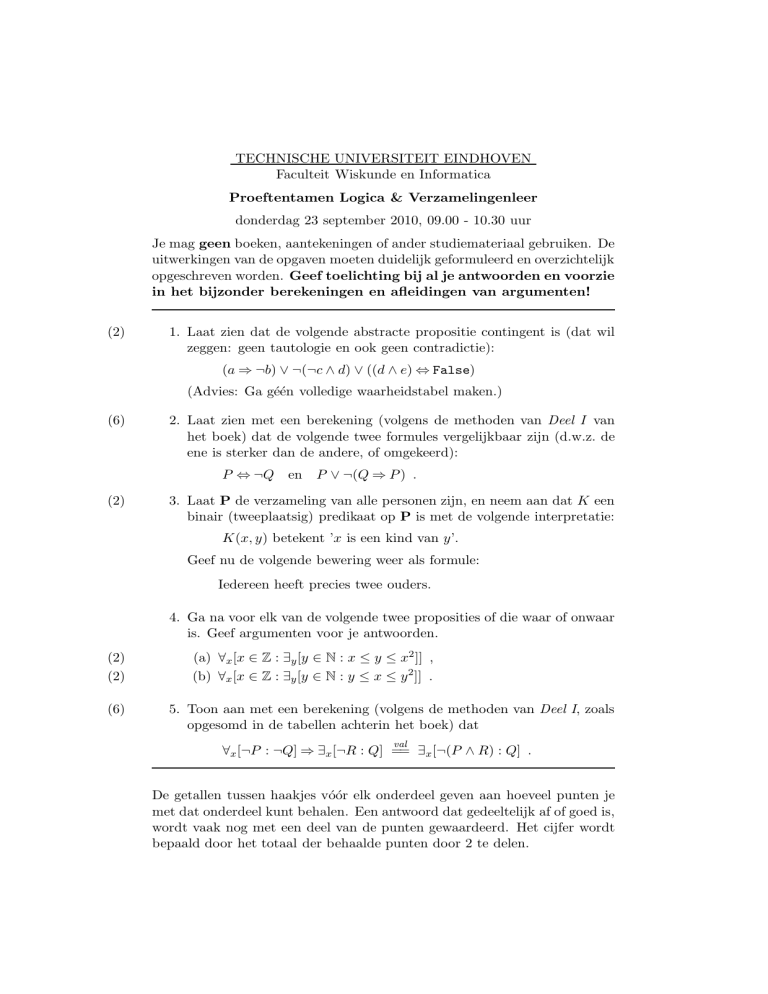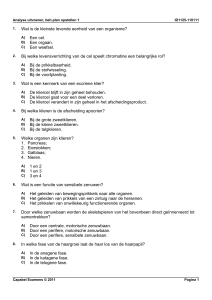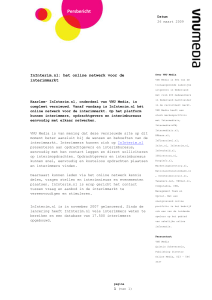
TECHNISCHE UNIVERSITEIT EINDHOVEN
Faculteit Wiskunde en Informatica
Proeftentamen Logica & Verzamelingenleer
donderdag 23 september 2010, 09.00 - 10.30 uur
Je mag geen boeken, aantekeningen of ander studiemateriaal gebruiken. De
uitwerkingen van de opgaven moeten duidelijk geformuleerd en overzichtelijk
opgeschreven worden. Geef toelichting bij al je antwoorden en voorzie
in het bijzonder berekeningen en afleidingen van argumenten!
(2)
1. Laat zien dat de volgende abstracte propositie contingent is (dat wil
zeggen: geen tautologie en ook geen contradictie):
(a ⇒ ¬b) ∨ ¬(¬c ∧ d) ∨ ((d ∧ e) ⇔ False)
(Advies: Ga géén volledige waarheidstabel maken.)
(6)
2. Laat zien met een berekening (volgens de methoden van Deel I van
het boek) dat de volgende twee formules vergelijkbaar zijn (d.w.z. de
ene is sterker dan de andere, of omgekeerd):
P ⇔ ¬Q en
(2)
P ∨ ¬(Q ⇒ P ) .
3. Laat P de verzameling van alle personen zijn, en neem aan dat K een
binair (tweeplaatsig) predikaat op P is met de volgende interpretatie:
K(x, y) betekent ’x is een kind van y’.
Geef nu de volgende bewering weer als formule:
Iedereen heeft precies twee ouders.
4. Ga na voor elk van de volgende twee proposities of die waar of onwaar
is. Geef argumenten voor je antwoorden.
(2)
(2)
(6)
(a) ∀x [x ∈ Z : ∃y [y ∈ N : x ≤ y ≤ x2 ]] ,
(b) ∀x [x ∈ Z : ∃y [y ∈ N : y ≤ x ≤ y 2 ]] .
5. Toon aan met een berekening (volgens de methoden van Deel I, zoals
opgesomd in de tabellen achterin het boek) dat
val
∀x [¬P : ¬Q] ⇒ ∃x [¬R : Q] == ∃x [¬(P ∧ R) : Q] .
De getallen tussen haakjes vóór elk onderdeel geven aan hoeveel punten je
met dat onderdeel kunt behalen. Een antwoord dat gedeeltelijk af of goed is,
wordt vaak nog met een deel van de punten gewaardeerd. Het cijfer wordt
bepaald door het totaal der behaalde punten door 2 te delen.
TECHNISCHE UNIVERSITEIT EINDHOVEN
Faculteit Wiskunde en Informatica
Trial examination Logic and Set Theory
Thursday September 23, 2010, 09.00 - 10.30 hrs.
You are not allowed to use any books, notes or other course material. Your
solutions to the problems have to be formulated and written down in a
clear and precise manner. Provide arguments and explanations for
all your answers, and, in particular, do not omit arguments from
your calculations and derivations!
(2)
1. Show that the following abstract proposition is contingent (i.e. neither
a tautology, nor a contradiction):
(a ⇒ ¬b) ∨ ¬(¬c ∧ d) ∨ ((d ∧ e) ⇔ False)
(Advice: Do not construct a complete truth table.)
(6)
2. Prove with a calculation (according to the methods of Part I of the
book) that the following two formulas are comparable (i.e., the one is
stronger than the other, or vice versa):
P ⇔ ¬Q and
(2)
P ∨ ¬(Q ⇒ P ) .
3. Let P be the set of all people and suppose that K is a binary predicate
on P with the following interpretation:
K(x, y) means ‘x is a child of y’ .
Write the following statement as a formula:
Everybody has exactly two parents.
4. Check, for each of the following two propositions whether it is true or
false. Give arguments for your answers.
(2)
(2)
(6)
(a) ∀x [x ∈ Z : ∃y [y ∈ N : x ≤ y ≤ x2 ]] ,
(b) ∀x [x ∈ Z : ∃y [y ∈ N : y ≤ x ≤ y 2 ]] .
5. Prove with a calculation (according to the methods in Part I listed in
the tables at the end of the book) that
val
∀x [¬P : ¬Q] ⇒ ∃x [¬R : Q] == ∃x [¬(P ∧ R) : Q] .
The number between parentheses in front of a problem indicates how many
points you score with a correct answer to it. A partially correct answer is
usually awarded with a fraction of those points. The final grade will be
determined by dividing the total number of scored points by 2.












